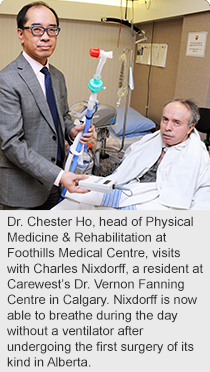
April 27, 2015
Story by Greg Harris; photo by Paul Rotzinger
Heading out to the local cinema to catch a movie is an entertainment option most of us take for granted.
But for Charles Nixdorff, a 57-year-old quadriplegic man, taking in a film without being tied to his ventilator has been out of the question – until now.
In the first procedure of its kind performed in Alberta, Nixdorff has had a pacing device implanted in his diaphragm, which lets him breathe during the day without the help of the ventilator.
 Since the surgery last October, the resident at Carewest’s Dr. Vernon Fanning Centre in Calgary has even progressed to a point where he is able to breathe for up to 40 minutes entirely unassisted.
Since the surgery last October, the resident at Carewest’s Dr. Vernon Fanning Centre in Calgary has even progressed to a point where he is able to breathe for up to 40 minutes entirely unassisted.
“I like to avoid the ventilator as much as possible,” Nixdorff says. “It’s much more natural to be on the pacer. This is definitely an improvement.”
Called the NeuRx Diaphragm Pacing System, the unit provides an electrical impulse to stimulate the diaphragm just as a cardiac pacemaker provides an impulse to stimulate the heart muscle. The diaphragm pacer is controlled by an external device, which can regulate the frequency of breaths, their depth and their duration.
Dr. Chester Ho, head of Physical Medicine & Rehabilitation at Foothills Medical Centre, spearheaded the pacer insertion, which included financial support from Alberta Health Services (AHS), through the Neuromodulation Program in the Department of Clinical Neurosciences.
“This is something of a test case and we’ll be watching closely to see how Mr. Nixdorff progresses,” says Dr. Ho, also an associate professor at the University of Calgary’s Cumming School of Medicine. “Our hope is that he continues to increase the amount of time during the day he is on the pacing device.”
Pacing devices reduce the risk of infection and irritation to airways, as well as enhance safety and mobility, since patients aren’t attached to any tubing. Patients in an institutional setting remain on the ventilator at night as a safety precaution.
Dr. Karen Rimmer, an AHS respirologist who provides care to Nixdorff and other patients on ventilators, says there are relatively few suitable candidates for the pacing device.
“It all depends on the type of injury they’ve had,” Dr. Rimmer says. “The phrenic nerve, which powers the diaphragm, must still be intact in order for this therapy to work.”
There is currently one other Alberta patient in Edmonton who is being considered for the procedure.
Although this form of therapy has been used in the U.S. and some European countries, it’s still relatively new to Canada with only a handful of centres having performed the procedure.
The pacing device is implanted via laparoscopic surgery and is connected externally to a handheld control system.
Calgary surgeon Dr. Sean McFadden performed the surgery on Nixdorff.
Although it takes time for a patient’s phrenic nerve and diaphragm to regain conditioning, some patients do extremely well and are eventually able to breathe unassisted.
“The device has improved Charles’ quality of life in that it has given him more confidence,” says Beverley Forbes, Carewest client service manager at the Fanning Centre. “When you’re relying on a machine to breathe, you realize how dependent you are. But the pacing device offers some independence from that – we’re thrilled to be a part of it.”
Gwen Dunn, who with respiratory therapists Elaina Zebroff and Lorne Howie work closely with Nixdorff, says the improvements brought about by the pacing device have been significant, one example being the recent ventilator-free outing to Sunridge Spectrum Cinemas.
“Charles is more comfortable on the pacer and I think he has come out of himself a little bit more,” says Dunn, a member of the Chronic Ventilator Program in AHS’ Calgary Zone. “For respiratory therapists like me, to help give someone back his breathing is really up there professionally.”
Prior to his injury, which occurred when he fell down the stairs and struck his head while trying to move a chair, Nixdorff had a mixed farming operation near Airdrie, which is now overseen by his brother.